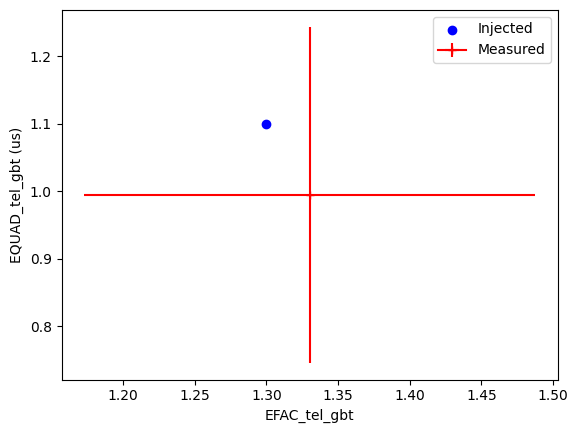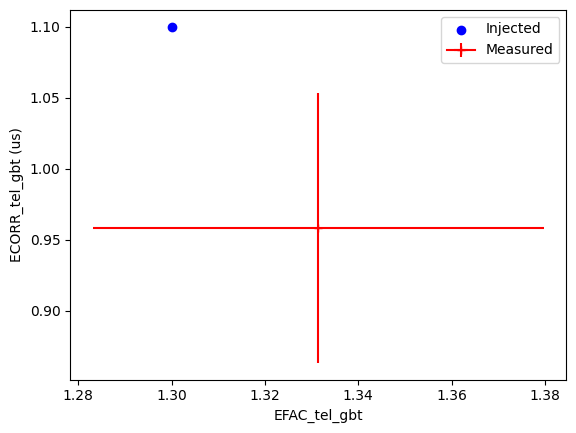This Jupyter notebook can be downloaded from noise-fitting-example.ipynb, or viewed as a python script at noise-fitting-example.py.
PINT Noise Fitting Examples
[1]:
from pint.models import get_model
from pint.simulation import make_fake_toas_uniform
from pint.logging import setup as setup_log
from pint.fitter import Fitter
import numpy as np
from io import StringIO
from astropy import units as u
from matplotlib import pyplot as plt
[2]:
setup_log(level="WARNING")
[2]:
1
Fitting for EFAC and EQUAD
[3]:
# Let us begin by simulating a dataset with an EFAC and an EQUAD.
# Note that the EFAC and the EQUAD are set as fit parameters ("1").
par = """
PSR TEST1
RAJ 05:00:00 1
DECJ 15:00:00 1
PEPOCH 55000
F0 100 1
F1 -1e-15 1
EFAC tel gbt 1.3 1
EQUAD tel gbt 1.1 1
TZRMJD 55000
TZRFRQ 1400
TZRSITE gbt
EPHEM DE440
CLOCK TT(BIPM2019)
UNITS TDB
"""
m = get_model(StringIO(par))
ntoas = 200
# EFAC and EQUAD cannot be measured separately if all TOA uncertainties
# are the same. So we must set a different toa uncertainty for each TOA.
# This is how it is in real datasets anyway.
toaerrs = np.random.uniform(0.5, 2, ntoas) * u.us
t = make_fake_toas_uniform(
startMJD=54000,
endMJD=56000,
ntoas=ntoas,
model=m,
obs="gbt",
error=toaerrs,
add_noise=True,
include_bipm=True,
include_gps=True,
)
[4]:
# Now create the fitter. The `Fitter.auto()` function creates a
# Downhill fitter. Noise parameter fitting is only available in
# Downhill fitters.
ftr = Fitter.auto(t, m)
[5]:
# Now do the fitting.
ftr.fit_toas()
[6]:
# Print the post-fit model. We can see that the EFAC and EQUAD have been
# and the uncertainties are listed.
print(ftr.model)
# Created: 2024-05-01T16:49:52.495072
# PINT_version: 1.0+37.g68701b9
# User: docs
# Host: build-24247204-project-85767-nanograv-pint
# OS: Linux-5.19.0-1028-aws-x86_64-with-glibc2.35
# Python: 3.11.6 (main, Feb 1 2024, 16:47:41) [GCC 11.4.0]
# Format: pint
PSR TEST1
EPHEM DE440
CLOCK TT(BIPM2019)
UNITS TDB
START 53999.9999999847401968
FINISH 56000.0000000040553704
DILATEFREQ N
DMDATA N
NTOA 200
CHI2 199.99999998662568
CHI2R 1.0362694299825166
TRES 2.097514626820151052
RAJ 4:59:59.99999219 1 0.00000747661397716133
DECJ 15:00:00.00073715 1 0.00066123774978884794
PMRA 0.0
PMDEC 0.0
PX 0.0
F0 99.99999999999985088 1 3.013459117905314563e-13
F1 -1.0000157488539169711e-15 1 1.3509609570679175329e-20
PEPOCH 55000.0000000000000000
PLANET_SHAPIRO N
EFAC tel gbt 1.3155333561285645 1 0.18935541327251668
EQUAD tel gbt 1.0816780485861377 1 0.3172201845504371
TZRMJD 55000.0000000000000000
TZRSITE gbt
TZRFRQ 1400.0
[7]:
# Let us plot the injected and measured noise parameters together to
# compare them.
plt.scatter(m.EFAC1.value, m.EQUAD1.value, label="Injected", marker="o", color="blue")
plt.errorbar(
ftr.model.EFAC1.value,
ftr.model.EQUAD1.value,
xerr=ftr.model.EFAC1.uncertainty_value,
yerr=ftr.model.EQUAD1.uncertainty_value,
marker="+",
label="Measured",
color="red",
)
plt.xlabel("EFAC_tel_gbt")
plt.ylabel("EQUAD_tel_gbt (us)")
plt.legend()
plt.show()

Fitting for ECORRs
[8]:
# Note the explicit offset (PHOFF) in the par file below.
# Implicit offset subtraction is typically not accurate enough when
# ECORR (or any other type of correlated noise) is present.
# i.e., PHOFF should be a free parameter when ECORRs are being fit.
par = """
PSR TEST2
RAJ 05:00:00 1
DECJ 15:00:00 1
PEPOCH 55000
F0 100 1
F1 -1e-15 1
PHOFF 0 1
EFAC tel gbt 1.3 1
ECORR tel gbt 1.1 1
TZRMJD 55000
TZRFRQ 1400
TZRSITE gbt
EPHEM DE440
CLOCK TT(BIPM2019)
UNITS TDB
"""
m = get_model(StringIO(par))
# ECORRs only apply when there are multiple TOAs per epoch.
# This can be simulated by providing multiple frequencies and
# setting the `multi_freqs_in_epoch` option. The `add_correlated_noise`
# option should also be set because correlated noise components
# are not simulated by default.
ntoas = 500
toaerrs = np.random.uniform(0.5, 2, ntoas) * u.us
freqs = np.linspace(1300, 1500, 4) * u.MHz
t = make_fake_toas_uniform(
startMJD=54000,
endMJD=56000,
ntoas=ntoas,
model=m,
obs="gbt",
error=toaerrs,
freq=freqs,
add_noise=True,
add_correlated_noise=True,
include_bipm=True,
include_gps=True,
multi_freqs_in_epoch=True,
)
[9]:
ftr = Fitter.auto(t, m)
[10]:
ftr.fit_toas()
[10]:
True
[11]:
print(ftr.model)
# Created: 2024-05-01T16:50:13.774661
# PINT_version: 1.0+37.g68701b9
# User: docs
# Host: build-24247204-project-85767-nanograv-pint
# OS: Linux-5.19.0-1028-aws-x86_64-with-glibc2.35
# Python: 3.11.6 (main, Feb 1 2024, 16:47:41) [GCC 11.4.0]
# Format: pint
PSR TEST2
EPHEM DE440
CLOCK TT(BIPM2019)
UNITS TDB
START 53999.9999999862692246
FINISH 55984.0000000565303704
DILATEFREQ N
DMDATA N
NTOA 500
CHI2 499.999417569325
CHI2R 1.016258978799441
TRES 1.8164493495535257736
RAJ 4:59:59.99999856 1 0.00000654262561217618
DECJ 15:00:00.00087024 1 0.00056225453832578162
PMRA 0.0
PMDEC 0.0
PX 0.0
F0 100.00000000000013291 1 2.5566076338250465624e-13
F1 -1.0000225417180075602e-15 1 1.17200255206738780265e-20
PEPOCH 55000.0000000000000000
TZRMJD 55000.0000000000000000
TZRSITE gbt
TZRFRQ 1400.0
PHOFF 1.163497986784948e-05 1 1.9360289198082786e-05
PLANET_SHAPIRO N
EFAC tel gbt 1.2879234985415704 1 0.04666147895208268
ECORR tel gbt 1.2477615906241342 1 0.10166389847639333
[12]:
# Let us plot the injected and measured noise parameters together to
# compare them.
plt.scatter(m.EFAC1.value, m.ECORR1.value, label="Injected", marker="o", color="blue")
plt.errorbar(
ftr.model.EFAC1.value,
ftr.model.ECORR1.value,
xerr=ftr.model.EFAC1.uncertainty_value,
yerr=ftr.model.ECORR1.uncertainty_value,
marker="+",
label="Measured",
color="red",
)
plt.xlabel("EFAC_tel_gbt")
plt.ylabel("ECORR_tel_gbt (us)")
plt.legend()
plt.show()
